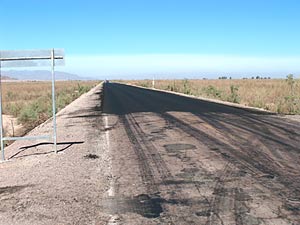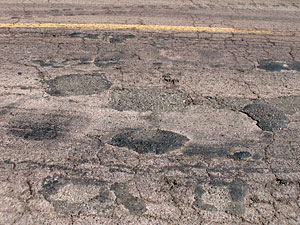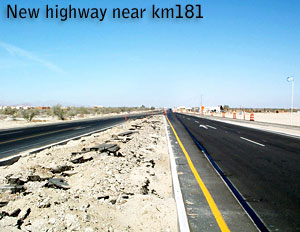The Highway from Mexicali to
San Felipe - October 23, 2007
Highway 5 from Mexicali to San Felipe has always been
a cosmetologist's nightmare. The road surface is in
a perpetual state necrotizing fasciitis, a
kind of bituminous apshalt-eating disease. Due to the
increased traffic resulting from the local real estate
and development activity -higher numbers of heavy freight
trucks, mobile homes and RVs -the road surface has incurred
an accelerated course of stress and fatigue.
 The
road repair crews have made an effort to stay on top
of it. But until recently, their solution was to mix
up a pot of asphalt and dump it into a pothole, leaving
it proud so the tires of passing cars could flatten
it level with the road.
The
road repair crews have made an effort to stay on top
of it. But until recently, their solution was to mix
up a pot of asphalt and dump it into a pothole, leaving
it proud so the tires of passing cars could flatten
it level with the road.
Earlier this year Mexicali committed several scrapers,
rollers and pavers to applying new asphalt coats to
several areas of the highway.
Entering Mexico through the old border crossing, the
traffic moves efficiently because of the overpasses
built in the last few years. New large and readable
road signs indicate the direction to San Felipe are
a welcome addition to Mexicali's ongoing makeover. But
these signs revert to their tired predecessors at the
last circle intersection and it requires some intuition
to realize you need to be in the right or center lane
to make the angled exit that crosses the railroad tracks.
There is a stop sign just before the tracks, which no
one observes. It's a good idea to stop here, if only
briefly, to avoid a traffic ticket from any lurking
police who use the traffic flow as a lure.
Road surfaces in Mexicali vary, but on the route to
San Felipe they are pebbly and at places offer a selection
of drained varicose veins. The traffic is always frenetic
when passing through the city. Cars, trucks and buses
commit to rapid lane changes without the virtue of signaling.
Horns are sounded and lights are flashed to motivate
any hesitant pilgrim.
At the southern outskirts of Mexicali, near the shoulder
sign indicating 190 kms to San Felipe, the 4 lane road
surface smoothes out into new blacktop, in places baptized
by the blood of the ubiquitous dead canine.
At kilometer 17 the new blacktop reverts to old asphalt
for 4 kilometers then magically smoothes to new surface
again. At kilometer 35 the highway is old again, made
drivable by numerous patches.
Just past the Algadones turnoff, the highway funnels
into two lanes (north/south) and immediately offers
up a recently applied layer of asphalt. As the foothills
approach and the highway begins its twists and mountain
turns, an extraordinary sight greets the windshield
on a particularly curvaceous trajectory. A shiny new
guardrail. This is a nod toward traffic safety that
for generations has been conspicuously absent between
Mexicali and San Felipe. The gift is largely symbolic,
however. The majority of highway switchbacks and twisting
shoulders remain unpromoted by the steel epaulets and
offer only a brief panoramic delight before sending
a driver with attention deficit disorder sailing toward
his or her crucifix at the bottom of an arroyo or ravine.
It would appear it will be some time yet before sufficient
guardrails are erected to separate the living from the
collections of crosses beyond them.
Past Cucapa Mayor the road surface is so new the lanes
have yet to be painted. But the fresh asphalt is short-lived
and the road returns to old surface. The 'causeway',
that long stretch crossing the dry southern remnant
of Laguna la Salada at around km 91, has a short swath
of old road top at both ends and is most new asphalt
in between.
The highway does a leapfrog presentation of new and
old road surface for most of its remaining run to San
Felipe. There are areas that sport a new coat of asphalt
for three or four kilometers only to fall back on stretches
of disrepair. In a few places, particularly south of
km 158, potholes yawn with the boredom of the neglected.
 Once
past the drugs and arms inspection campment near kilometer
44, the area shows signs of exploitation and profit-mining.
Billboards announce future and fledgling developments.
Hyperbole and exaltation are their sales idioms and
they share the same DNA as any billboard that has graced
an arid, desolate landscape prior to its occupation
by confidence people.
Once
past the drugs and arms inspection campment near kilometer
44, the area shows signs of exploitation and profit-mining.
Billboards announce future and fledgling developments.
Hyperbole and exaltation are their sales idioms and
they share the same DNA as any billboard that has graced
an arid, desolate landscape prior to its occupation
by confidence people.
Roadbed preparations for another two lanes make an
appearance around km 169, south of which spread an array
of real estate billboards all the way to San Felipe.
El Dorado heralds a short stretch of usable 4 lane but
the true division of north and south traffic appears
near km 181. The final six miles into San Felipe reflect
meridians and boulevards, yet to be landscaped. Major
or future influential intersections bristle with lamp
standards and turn offs. It would seem the north campos
are to have the black carpet treatment.
Entry into town remains two lane but is channeled to
the Malecón through an endless series of stop
signs. Prior to that the lane markings are confused,
old lines from prior single lane careers showing through
the newer paint. It's best to judge your lane by the
shoulders and hazard sign locations rather than follow
a streak of pigment into a concrete boulevard buttress.
Since San Felipe has been targeted by F.O.N.A.T.U.R
- National Trust Fund for Tourism Development - to be
one of Baja's great resort destinations, one would think
tourist attractions would be linked to the their targets
by healthy roads. Apparently this isn't the case. Or
perhaps the machinery required to develop an area is
inimicable to asphalt to the extent the roads are not
worth repairing until the final deed is done, much as
laying carpet in a newly built home is the last stage
of construction.
So why is the old highway wearing out?
Asphalt, a brownish-black goo of hydrocarbons left
over from oil refining, acts as the glue that holds
together a mix of rocks and sand to form paving material.
When asphalt, or indeed any material, experiences stress,
the bonds between adjacent atoms or molecules break
apart, forming microscopic cracks. If the stress continues,
these tiny cracks grow and coalesce into big cracks.
Vibration measurements show that highways lose their
structural integrity long before you can see cracks
on the surface. This emphasizes the need for the early
maintenance of roads to prevent their deterioration.
 The
average life span of an asphalt highway is 20 years.
In the United States, research is underway to develop
tests that will yield specifications that'll allow a
highway's longevity to be predicted with a greater degree
of accuracy. Modified binder research will help to develop
an adhesion for the aggregates that will last beyond
the current life span. Binders function as an inexpensive,
waterproof, thermoplastic adhesive. In other words,
they act as the glue that holds the road together. Scientists
are now introducing polymers into the binder mix to
develop a self-healing brand of asphalt
The
average life span of an asphalt highway is 20 years.
In the United States, research is underway to develop
tests that will yield specifications that'll allow a
highway's longevity to be predicted with a greater degree
of accuracy. Modified binder research will help to develop
an adhesion for the aggregates that will last beyond
the current life span. Binders function as an inexpensive,
waterproof, thermoplastic adhesive. In other words,
they act as the glue that holds the road together. Scientists
are now introducing polymers into the binder mix to
develop a self-healing brand of asphalt
Subgrade preparation, base selection, drainage design,
thickness design, joint design, and shoulder characterization
are obviously of immense importance as well. A road
will deteriorate quickly without the necessary support.
Texas has come up with the Superpave binder specification.
It classifies binders into performance grades, based
on a range of climates and pavement temperatures. The
physical properties required for the binder are the
same for all grades, but the temperature at which those
properties must be attained is determined by the specific
climatic conditions at the paving location. The specification
applies to all unmodified binders and many modified
binders.
The tests mimic actual environmental and traffic conditions
at the project site. The results of the dynamic shear
test indicate the binder's ability to withstand permanent
deformation (which is often evidenced as rutting in
the pavement) and fatigue cracking. The bending beam
test results are used to predict low-temperature cracking
problems. The results of the direct tension test provide
additional information on how the hinder will perform
at low temperatures.
The Superpave system includes mix analysis procedures
that predict how well a mix will perform in the field.
These procedures are intended to provide additional
information on asphalt mixes that will be placed in
pavements with very high traffic volumes and loads.
Two new, sophisticated pieces of laboratory equipment
-the Superpave shear tester and the indirect tensile
tester -are used to measure specific engineering properties
of the laboratory-compacted asphalt mix. The test results
are then entered into software models that predict how
many equivalent single-axle loads the pavement will
carry, or how much time will elapse, before a certain
level of rutting, fatigue cracking, or low-temperature
cracking develops.
Superpave binders are designated with a "PG"
(performance grade) rating. The first number in the
rating indicates the high-temperature grade; the second
indicates the low-temperature grade. For example, a
binder classified PG58-28 would meet the required physical
properties at pavement temperatures as high as 58 degrees
C and as low as -28 degrees C. The mix designer selects
a Superpave binder based on the climate in which the
pavement will serve and the traffic it will bear.
Before the existing highway is mollified by a thin
sheet of asphalt ironed onto its existing defects, maybe
the Mexican government will become more interested in
the science of avant asphalt technologies and gift to
our area an avenue of transportation that will gracefully
grow old with the town of San Felipe. Hey, we can always
hope, can't we?